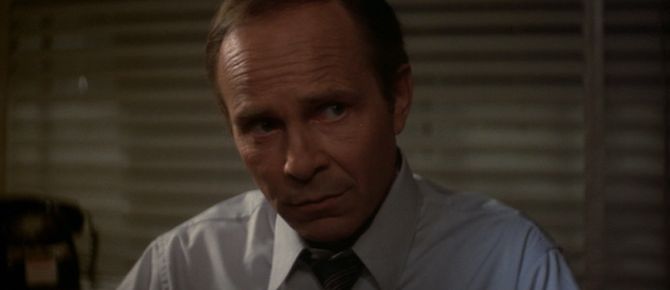 Back to selection
Back to selection
The Blue Velvet Project
Blue Velvet, 47 seconds at a time by Nicholas Rombes
The Blue Velvet Project, #117

Second #5499, 91:39
This look—this sharp, suspicious, and accusatory look—is passed between Detective Williams and Jeffrey just moments after Jeffrey describes Frank as “a sick and dangerous man.” In the temporal flow of the film, the moment of this gaze passes very quickly, as the narrative draws our attention to what Jeffrey (who has brought along his black and white surveillance photographs) tells Detective Williams about Frank and his dark goings-on. And yet, when the film is frozen and this frame from second #5499 is de-linked from linear chronology, the Detective’s look takes on a new shade of meaning, one that suggests that perhaps Jeffrey, as well as Frank, is a “sick and dangerous man.” There is something in that look, those eyes, that suggests that Detective Williams sees the dark folds in Jeffrey’s soul that are hidden to others, and that in this look at this moment he signals to Jeffrey that he knows.
In his classic 1970 text Ideology and Ideological State Apparatuses the Marxist theorist Louis Althusser (who strangled to death his wife and so knows, ahem, a thing or two about “apparatuses”) wrote this:
I shall then suggest that ideology ‘acts’ or ‘functions’ in such a way that it ‘recruits’ subjects among the individuals (it recruits them all), or ‘transforms’ the individuals into subjects (it transforms them all) by that very precise operation which I have called interpellation or hailing, and which can be imagined along the lines of the most commonplace everyday police (or other) hailing: ‘Hey, you there!’
Assuming that the theoretical scene I have imagined takes place in the street, the hailed individual will turn round. By this mere one-hundred-and-eighty-degree physical conversion, he becomes a subject. Why? Because he has recognized that the hail was ‘really’ addressed to him, and that ‘it was really him who was hailed’ (and not someone else). Experience shows that the practical telecommunication of hailings is such that they hardly ever miss their man: verbal call or whistle, the one hailed always recognizes that it is really him who is being hailed. And yet it is a strange phenomenon, and one which cannot be explained solely by ‘guilt feelings’, despite the large numbers who ‘have something on their consciences.’
For Althusser, this “hailing” was a metaphor for how the State constitutes and marks its subjects, or citizens. For to be called, to be hailed, to be named is to become, in that moment, bound. Bound to the gaze that demands that you respond, or at least acknowledge that you have been hailed.
And this is what Detective Williams (who is, after all, the figure of The Law, the figure of The Father) does at this moment: he hails Jeffrey, bringing him into the fold of Order. The Detective’s vision and ideology constitutes the ideology of the film. By the end, as everything returns to “normal” Jeffrey will be, once again, the dutiful subject, thanks, in no small part, to the seemingly small gesture of the Detective’s authoritarian gaze at this moment.
Over the period of one full year — three days per week — The Blue Velvet Project will seize a frame every 47 seconds of David Lynch’s classic to explore. These posts will run until second 7,200 in August 2012. For a complete archive of the project, click here. And here is the introduction to the project.
